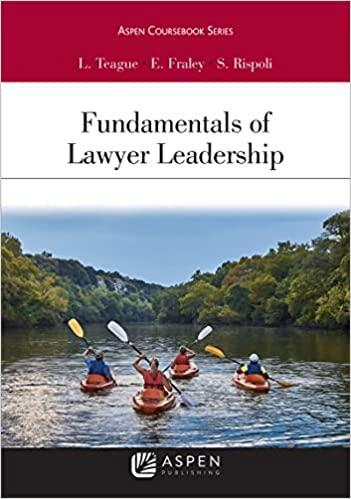Question
You are a trainee solicitor with the firm of Robinsons LLP of 36 Avenue Way, Christlethorpe, Guildshire GU18 9ZX. You have been asked by your
You are a trainee solicitor with the firm of Robinsons LLP of 36 Avenue Way, Christlethorpe, Guildshire GU18 9ZX.
You have been asked by your supervising solicitor, Rebecca Jones to contribute to your firm's in-house training programme.
Your supervising solicitor, Rebecca Jones is preparing a manual on various aspects of the Civil Procedure Rules (CPR) Part 36 and Practice Direction (PD) 36. You are asked to contribute towards this by completing Examples 2 to 5 inclusive taken from the draft manual entries set out below.
You must ensure that you follow the required format (illustrated by Example 1 that has been completed by your supervisor) of answering each question by reference to any relevant facts given in the question and the relevant law, including CPR Part 36, PD 36, case law, practitioner texts and practitioner resources.
Your supervising solicitor, Rebecca Jones makes it clear to you that legal research is required and the manual must not simply contain material cut and pasted from the CPR or any other sources. Concise and precise information is required that answers each practical question and any sub-questions fully and accurately with any relevant legal authorities properly cited.
The facts of one example do not relate to the facts of any other example. Each example question should be answered only from its own facts.
NOTE TO THE CITATION OF LEGAL AUTHORITIES
Any relevant legal authorities, including their citations, must be included in your answers to the questions for Examples 2 to 5 inclusive. See further the answers to questions (i) and (ii) of Example 1.
Robinsons LLP Training Manual: Part 36Introduction: why our clients should consider making a Part 36 offer
A Part 36 offer provides a means of putting real pressure on an opponent to settle a case and, to some extent, of protecting our client's position on costs. If a defendant makes a Part 36 offer and the claimant does not accept it but at trial fails to obtain a judgment more advantageous than that offer, the claimant will usually suffer severe financial penalties. Likewise, if a claimant makes a Part 36 offer which is not accepted and the judgment against the defendant is at least as advantageous to the claimant as the proposals contained in their Part 36 offer, the defendant will usually suffer severe financial penalties.
Scope of these notes
These notes only concern offers made in non-personal injury claims made under Section I of CPR Part 36. All materials relating to personal injury claims and Section II have been removed.
Any reference to the standard and indemnity bases of the assessment of legal costs are not explained in these notes as these are addressed in a different part of the manual.
Formalities
Example 1
CPR, rule 36.5(1) provides that a Part 36 offer must? (a) be in writing; (b) make clear that it is made pursuant to Part 36; (c) specify a period of not less than 21 days within which the defendant will be liable for the claimant's costs in accordance with rule 36.13 if the offer is accepted;
(d) state whether it relates to the whole of the claim or to part of it or to an issue that arises in it and if so to which part or issue; and (e) state whether it takes into account any counterclaim.
Questions (i) To comply with (a), must the Part 36 offer always be made in a letter?
(ii) To comply with (b), must the Part 36 offer state that "this offer is made pursuant to Part 36"?
(iii) What does (c) mean?
Answers
(i) No, PD 36 para.1.1 provides that alternatively a "Part 36 offer may be made using Form N242A". Practical Law in the Practice Note, "Part 36 Offers: form and content requirements" (Resource ID 1-598-0505) (https://uk.practicallaw.thomsonreuters.com accessed on [date]) suggests that making a Part 36 offer in an email would also count as an offer in writing relying on the authority ofThomas v Home Office[2006] EWCA Civ 1355.
(ii) No, as the White Book ([year], Sweet & Maxwell) states in Volume 1, Section A at paragraph [number], this formality would be satisfied by, for example, a simple statement in a letter that the offer is made pursuant to Part 36 or perhaps a heading of "PART 36 OFFER".
(iii) The "period" referred to in (c) is defined in rule 36.3(g) as "the relevant period".
To make an effective Part 36 offer, the offeror must make it clear that if the offeree accepts the offer within the relevant period, being 21 days or more from when the offer was made, the defendant will become liable to pay the claimant's costs up to the date of acceptance of the offer. This is the effect of rule 36.13(1).
Rule 36.3(g)(ii) provides that if a Part 36 offer is made within 21 days of the start of a trial, the relevant period is the period until the end of the trial.
Service of a Part 36 Offer and calculation of the relevant period
The service of a Part 36 offer and calculation of the relevant period is illustrated by the example that follows. It is based on 2 months from the fictitious calendar year of 20XX set out below.
Calendar for 20XX
Example 2
Question

Step by Step Solution
There are 3 Steps involved in it
Step: 1

Get Instant Access to Expert-Tailored Solutions
See step-by-step solutions with expert insights and AI powered tools for academic success
Step: 2

Step: 3

Ace Your Homework with AI
Get the answers you need in no time with our AI-driven, step-by-step assistance
Get Started


